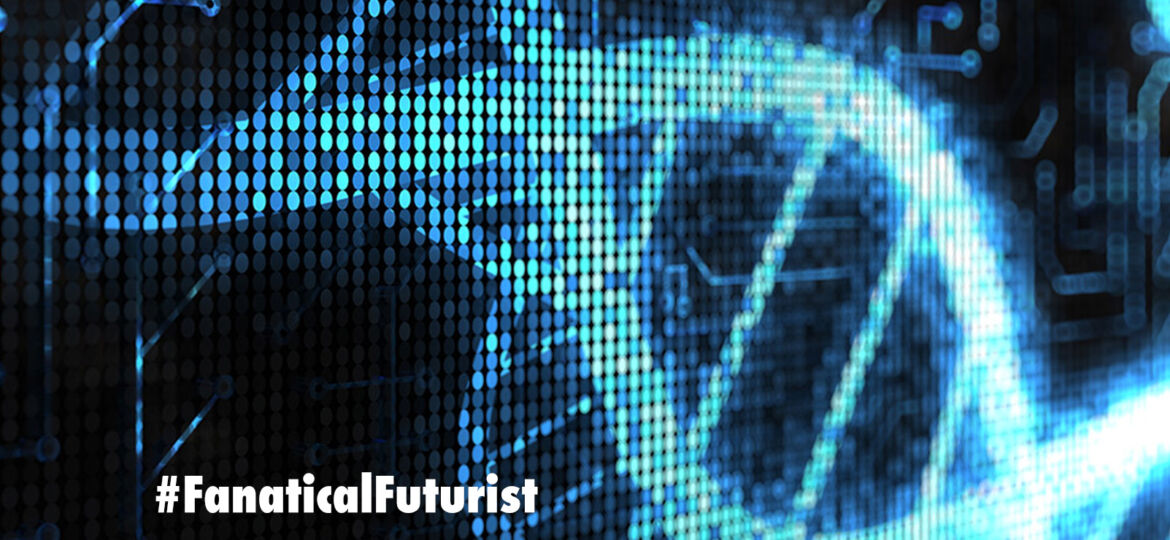
WHY THIS MATTERS IN BRIEF
Storing and processing huge amounts of data requires huge power hungry hyperscale datacenters, which could all be replaced with DNA and Molecular computers the size of a table, powered by a car battery.
This week Intelligence Advanced Research Projects Activity (IARPA), a group within the Office of the Director of National Intelligence that develops technologies for US intelligence community like the CIA and NSA, announced its plans to develop what it calls “tabletop sized machines that can store and retrieve data from DNA and other organic molecules,” such as large batches of polymers, and in doing so cut the costs of standing up and running a hyperscale datacenter from over $1 Billion today to $1 Million a year tomorrow. The US intelligence agencies get all the good toys including, potentially, the future unhackable Morpheus computer, a project run by IARPA’s cousin, DARPA. But that’s another story.
While all this might sound positively sci fi DNA storage is actually already arriving courtesy of our friends over at Microsoft, and others, who recently managed to store 215 petabytes of information in DNA, build a DNA file system to access and retrieve data, and then announced plans to make it available as a service via their Azure cloud in 2020. It’s also arriving from another strange angle – in our ability to turn living organisms, like bacteria, into living computers, the DNA of which was used recently to store and retrieve a movie clip from a live E. Coli bacteria.
Project launch: “Moving [the program] from from disbelief to doubt”
However, as for IARPA’s other objectives, the “machines,” DNA computers, which got a boost last year from a team at the University of Manchester when they published the first blueprint for one, and then performed an experiment to demonstrate that DNA computers would easily beat out Quantum computers to become the most powerful computers on Earth, and storing information in other types of organic molecules such as polymers, well, those aspirations are still a long way from being realised.
In the case of polymers though, which are long string like molecules, it’s highly likely that the teams involved in the project will attempt to store data in the sequence of individual atoms or groups of atoms within them, which in a room full of game changing concepts is a game changing concept itself…
The project, which was also reported by Nextgov, is an attempt to solve a basic problem of the modern era, namely the vast and growing costs of data storage. Datacenters around the world sucked up a tremendous 416 terawatt hours of electricity in 2016, or in other words about 3 percent of the world’s total electricity supply, according to the Independent, and account for at least 2 percent of global greenhouse gas emissions.
Asides from that though, while a friendlier environmental footprint is a bonus, the fact of the matter, from the US intelligence community’s perspective at least, is the fact that today they run huge hyperscale datacentre operations stuffed to the gills with traditional storage technologies that store all the data they’re hoovering up on flash drives, hard drives and, in some cases, tape drives. When you consider that the fact that DNA storage alone could store all the world’s data in something the size of a shoe box it’s easy to see why these technologies are of great interest. And that’s before we discuss the even bigger benefits of a revolutionary six base pair DNA computing and storage solution…
In addition to all that though, the benefits just keep piling up. In a 2016 paper in the journal BioMed Research International researchers found that DNA could store computer information more densely and for far longer periods of time, up to 425,000 years, require significantly less energy, and survive higher and lower temperatures than conventional hard drives.
IARPA officials said the new project, which they’re calling Molecular Information Storage (MIST), will be broken up into three chunks – a two year program to figure out how to store data in DNA or other molecules at high speeds, a two year program to figure out how to retrieve that data at high speeds, and a two year effort to develop an operating system that can run on that DNA, again, yes you’ve guessed it, at high speeds.
At the moment many of the technologies though that IARPA want to employ are still in the labs and untested at large scales, so it’s likely that even with the US Government’s involvement the first real prototypes are at least six years away with commercialisation likely following in the 2030’s.

















[…] Read the article online: https://www.fanaticalfuturist.com/2018/06/american-spy-agencies-dna-computers-store-information-in-m… […]